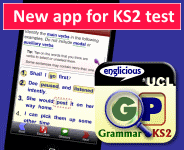Topic: Analysing grammatical structure
Englicious has a strong focus on the grammar of English and in this topic we look at how writers' grammatical choices influence how readers can interpret texts.
Englicious contains many resources for English language in schools, but the vast majority of them require you to register and log in first. For more information, see What is Englicious?


